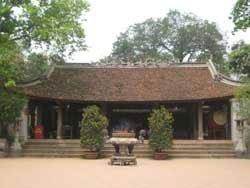Va Temple helps trace roots of traditional Vietnamese culture

The fresh breeze floating off the forest on Va Hill dispels the scorching heat of early summer. After travelling 50km by motorbike from the centre of ${bigcity_Hanoi:"Hanoi"} under the unrelenting sun, I am glad to finally get to the Va Temple to be welcomed by a green century-old forest. Va Hill is known in the region for its shape of a tortoise which is swimming towards the sun. For centuries, it has embraced the Va Temple located in Van Gia Village, Trung Hung Commune, Son Tay town in Ha Noi. The temple was recognised as a national cultural and historical vestige in 1964.
After going through the temple's imposing gate, I am surprisingly glad to see the golden flowers in the garden, which I often see flourish around $ {attraction_Hoan_Kiem_Lake:"Hoan Kiem Lake"} in the summer. All my tiredness and worries seem to disappear when I burn incense in my hands.
The Va Temple worships the God of Tan Vien Mountain (named Son Tinh), one of the Four Immortals in the Vietnamese pantheon. Built in the 17th century, the temple was also known as Dong Cung (Eastern Palace).
The temple and its gardens cover 2,000sq.m and are surrounded by a 2m high laterite wall.
Passing through its 300sq.m brick yard, I am impressed to see the old bell tower on my right and the imposing drum tower on my left.
Many precious objects have been preserved, including ornamental jars, vases, stone lampposts and bronze bells. The doors are carved with images of dragons and a phoenix.
The temple is usually deserted in the summer, but during festivals, it attracts thousands of pilgrims and tourists looking to trace the roots of traditional Vietnamese culture, explore its values, and pray for a better life.
The Va Temple Festival is a biannual event held in spring and autumn. The spring festival starts with a water procession early on the 15th day of the first lunar month.
Nguyen Van Tam, an elderly man from Van Gia Village, told me that during this festival, a boat with a palanquin holding a porcelain jar sails to the middle of the Red River, where Son Tinh is said to have swam.
"After a solemn ritual where a village elder uses a ladle to scoop water into the jar, the procession makes it way back to the temple to wash the statues," he explains.
The Autumn Festival, held on the 15th day of the 9th lunar month, is also known as the Fish Catching Festival. It celebrates Son Tinh teaching the local people the craft of fishing.
"Villagers catch 99 fish on the Tich River from which they make delicious food as an offering," Tam explains.
The ritual originates from a local legend that says Son Tinh helped the people catch 100 fish in a single day. He set free a pregnant catfish, and she gave birth to nine young that were transformed into stones, facing the Va Temple.
"The festival represents the locals wish for peace and an abundant harvest," says Tam.
"On this occasion, we sympathise more and share our ancestors' wish to conquer nature," confides Tam.
Tourists are also told another story about Son Tinh who became a national hero for helping the people to fight floods.
The legend says he married My Nuong, daughter of the 18th Hung King, but the Sea God, Thuy Tinh, also wanted to marry the princess. He became very jealous with Son Tinh and wanted to fight him. Thuy Tinh called on heavy rain, strong wind and angry seas to defeat him. However, as the sea levels rose, Son Tinh used his magic to create a mountain and dykes to protect the people and their property from the floods. The battle between the two Gods lasted for several weeks, and eventually, Thuy Tinh was defeated and forced to retreat back to his watery home. Son Tinh then organised a banquet to celebrate his glorious victory and founded a palace to commemorate his triumph. That palace is said to be the Va Temple.
Today, Vietnamese people remember clearly the famous myth of Mountain God Son Tinh and Sea God Thuy Tinh. It is said that Thuy Tinh has never given up on the idea of taking revenge to get My Nuong back and so every year, the people have to suffer floods as a consequence of Thuy Tinh's eternal bitterness and vengefulness.
Sitting under the old trees on a canvas, I enjoy the tranquillity while looking at the Tich River flowing softly by, with the green rice fields stretching as far as the eye can see. Of course, I don't forget to enjoy some banh te (rice cake), a speciality of the region.
The gentle smiles of the old women selling banh te and other goods at the temple warm me. Happiness is not something too far away.









